The Descent of my Saluki-male
“Daoud Osjan Al Firdous”
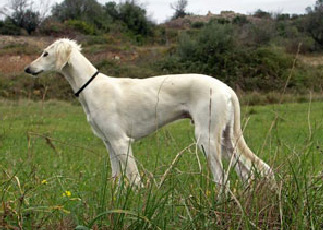
Bahrami Khaja Al Firdous (Sire, geb. 30.6.2006)
When I visited the Saluki World Congress in the last summer that took place 2008 in Finland, I have seen several hundred Salukis, which each really looked beautiful in its own way. But nobody I liked as much as my late Gorazan. This is understandable because the own dog is always the most beautiful, the dearest and the wisest one. In short, I realized that the time had not yet come to purchase a new dog, because I did not want to compare him with his beloved predecessor.
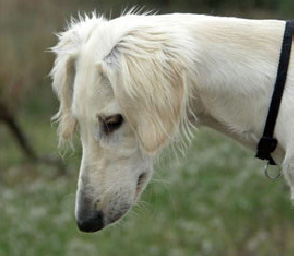
Bahrami Khaja Al Firdous (Sire, geb. 30.6.2006)
However, I found the reaction of a breeder very interesting, when I told her of my projects, that I perhaps want to get a puppy from the D-O Litter of Shera Chuat. She asked me with a slightly seen ironic smile, “Oh, this time no import?” Although this puppy is certainly an import, since it comes from Southern France, it is true that it is not a direct import from the countries of origin. This, however, the questioner certainly meant. Therefore, she was right but only in this case. But with this statement she expressed at the same time, that she probably did not understand my main concern, which is a diverse genome that promises health.
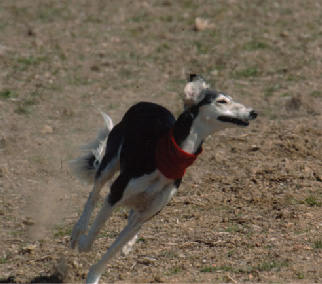
Rabi'a Chatun Al Firdous (Dam, geb. 26.5.2000)
If I choose a puppy, I watch the parents and their appearance first of all, and only afterwards I will have a look into the pedigree of the minded dog. But that all means the promised puppy's health is for me of main importance. However, I often have the impression that some breeders exclusively look into the pedigree of their breeding animals and notice the number of their titles, which may be significant for a mating.
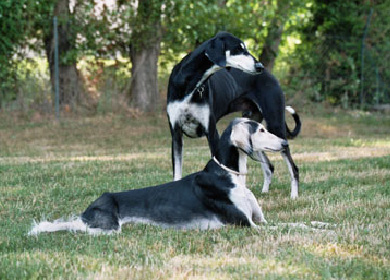
Rabi'a Chatun Al Firdous (Dam, geb. 26.5.2000)
Later on I had a second view into the Pedigree of my Daoud Osjan, which the lady-breeder Shera Chuat reared exemplarily until his sixth month of his life. I recognized, that there are twelve different kennel names in the first five generations. That was not bad at the first glance, but this can be terribly misleading, when an enormous inbreeding is discovered further on in the pedigrees and this is rejected by the puppy-buyer. Therefore a second, more careful look at the later generations is always necessary. This, determining later on - and my guess was right – I had recognized the old German type “von Arabien” at once, which go back to el Saluk and Sarona.
In the parental generation of Daoud I can find “Bahrami Khaja Al Firdous” (Brahmani Sawahin x Suleika Elishaba Al Firdous) and “Rabi'a Chatun Al Firdous” (Yoshua Tal Amal x Ta'izz Tal Amal), the sister of the famous stud-dog “Raquim Chalid Al Firdous”. Now I have a look to the dogs in the 3rd generation and their ancestors. All eight strains lead to the English Kennels Burydown, Knigtellington and Mazuri. Following these eight dogs, which were represented by Rahima's Behrouz El Hor (Male from Sweden), Ziba Talitha (Female from United States), Shafaq Lizmir La Zahir (Male from Sweden), Yanam Tal Amal (Female from Switzerland), Flare Min Al Aquila De Uchanes (Male from France), Pinari Tal Amal (Female from Switzerland), Ilias Sawahin (Male from Germany) and Munyah Sawahin (Bitch from Germany), I can find out, that the Pedigree of my Saluki-male “Daoud Osjan Al Firdous” is a practical example and a proof at the same time, that genes are really out of boundaries (see Miekeley, M.: Genes - without limits and borders; in UW 2/07, DWZRV Magazine, pages 13-16).
A worthy note is the English stud-dog “Burydown Uki” (Biwakuf von Sonnenheim x Ganetti von Arabien), from him the old German strains occur in all pedigrees of the eight several dogs, that were mentioned in the 3rd generation. On the maternal and paternal side of Daoud's Pedigree, namely through Yoshua and Yanam Tal Amal, the Tal Amal Y-Litter is represented twice. Therefore this doubling of the genes must have a special significance to my Saluki-dog. It should also be noted that the Kennel name of “Tal Amal” has meanwhile transferred into “Al Firdous”.
The Pedigree of my dog shows successfully and well-known Salukis just in the first three generations, which have really numerous titles, such as German Champion, International Champion, World Winners, Euro Winner, VDH Champion, Verbands- Winner, French Coursing Winner and French Working Champion. I found out that these dogs possess a particularly high gene-portion from the old German line. Nevertheless, the number of Champion titles can never be an only criterion of selection for me to acquire a puppy.
Burydown Uki I particularly want to mention, because he occurs as a ancestor twelve times at least in the previous pedigree-enquiries. During Uki's life, he had been mated with six different partners. The mating of “Biwakuf von Sonnheim” with “Ganetti von Arabien” had been an incest-mating between mother and son, that was done 1945 by members of the British Occupying Army in Berlin. This litter was born on 1st January, 1946. The genes and inheritance of the East-Prussian Bitch “Ganetti von Arabien” is thus doubly available from the beginning. This legacy has passed on to six different females and built different strains. Therefore it is no miracle that this type, which means elegant Salukis with a ravishing beautiful, narrow head, correct anatomy and light movement, has been maintained through an “open breeding method”. How is this to be explained? By taking repeatedly new partners (which is very important to have a blood booster) and building new strains, thus different gene combinations were possible during the last sixty years. In spite of all well-established and desired characteristics of the offspring and hoped heterozygosity. Anyway, it must certainly be remembered, that the diversity of a purebred dog is reduced by the selection of certain characteristics, because many genes were doubled in the same constellation and became therefore homozygous.
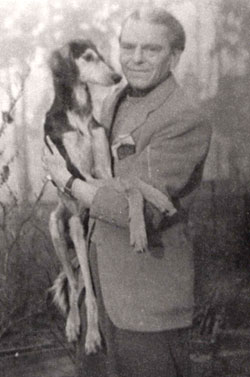
Assajan el Schahin (Dschanschal von Sonnenheim x Ramona von Arabien) with Mr. Astfalck (photo-archive: Dr. H. Renfordt-Voelkner)
Over “Ganetti von Arabien”, whose genes were also passed on by “Dschanschal von Sonnenheim”, which had been used for mating with “Ramona von Arabien” by Martha Astfalck-Vietz (el Schahin Kennel), Daoud is even far related to my deceased “Gorazan al-safi”.
This breeding method, to find always alternative gene combination by new partners, is promising not only health but preserves a desired type also. But unfortunately there is no one able to guarantee universal health, because life in general and breeding in particular is always a certain risk.
But since the dog's genome has already been researched and it is known that heterozygosity is required, DNA-testing may be helpful for the exploration of certain inherited diseases and the nature of specific genes (MHC), which view the diversity in a special strain.
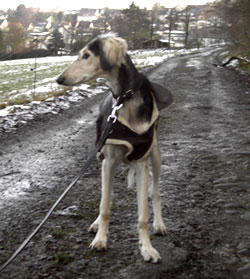
Daoud Osjan (Bahrami Khaja Al Firdous x Rabi'a Chatun Al Firdous) with 6,5 months in the Sauerland
I do want to mention that through a thoughtful mating what the Pedigree and the most ancestors of my dog show, and by a supposedly good cooperation between some of the breeders in the Present and Past, outstanding Salukis with beauty and powerful performance are obtained, for which this Breed had once been emerged. In this way the breeding of animals is to be wished!
Direct imports are for me a breeding necessity, because the orientation towards the origin is always required. Even if some Salukis from the countries of origin will not always meet the taste of a “Western eye”, they are definitely an urgent breeding need when more diversity is necessary for the dogs' vitality. So they are a repertoire for breeding and a challenge for breeders at the same time. Therefore I consider them as a genetic treasure chest. There are not meant those direct imports, of course, whose diversity has already reduced by a close line-breeding, that has done for a long time in the Western countries.
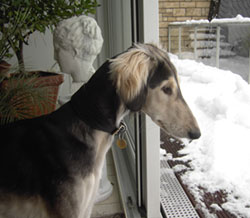
Portrait-study
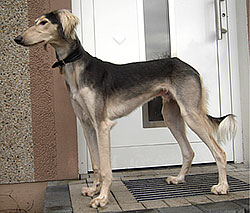
Side-standing (8 months old)
Daoud's ancestors have proved that they are not only beautiful but also powerful Salukis, as they have been successful in many sporting competitions the same time. And when I finally go back further on in the Pedigree of my new Friend, I will read the names of many well-known COO-imports, from the Twenties and Thirties of the previous Century which were imported to England by Lady Florence Amherst and General Lance. And what are a few decades in biological thinking!
In February 2009, Dr. Margrit Miekeley
All texts and images, except otherwise noted, copyright © Dr. Margrit Miekeley
